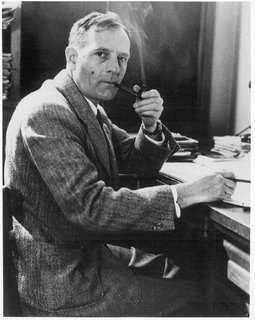Hubble's Universe

Edwin Hubble changed our understanding of the universe by showing, in 1929, that galaxies were moving away from Earth with a speed proportional to their distance or, in effect, that the universe itself was expanding.
Born on this day in 1889 in Marshfield, Missouri, Hubble took the long way around to becoming an astronomer -- although he had an interest in the stars from an early age (inspired in part by reading the novels of Jules Verne). A high school track star who broke the Illinois state high jump record, he attended the University of Chicago on a scholarship, lettering in track, basketball and boxing, and working as a lab assistant to famed physicist Robert Millikan. He went to Queens College Oxford as a Rhodes scholar in 1910 and studied Roman and English law, returning to the U.S. in 1913 to enter the bar. After a half-hearted year of practice in Louisville, Kentucky, he left the law to enter the University of Chicago again, this time as an astronomy graduate student. "I knew that even if I were second-rate or third-rate," he later recalled, "it was astronomy that mattered." After finishing his doctorate there, he turned down an invitation to join the staff of the prestigious Mt. Wilson Observatory to enter the Army in World War I.
After the War he did join Mt. Wilson, where he worked with the world's best telescope (100-inch) for almost the rest of his life. Before Hubble came onto the scene, there was no consensus as to the boundaries of our galaxy, the Milky Way, or with regard to whether certain spiral nebulae (far off, fuzzy patches of light) contained individual stars within our Milky Way or were separate "island universes." By accurately measuring the distance from Earth to the Andromeda nebula in 1924, Hubble not only showed that it was about 100,000 times further away from Earth as the nearest stars, but that the nebula was comparable in size to our own cluster of stars; the Andromeda nebula, it seemed, should be thought of as its own galaxy -- at least in light of the definition of the Milky Way previously proposed by Harlow Shapley. (When Hubble wrote to Shapley to report this, Shapley was heard to remark, "Here is the letter that has destroyed my universe.")
Hubble also used a spectograph to determine the Doppler shift of the light spectra coming from stars as they moved further away from the Earth, and plotted a formula showing that the "redshift" of light from distant galaxies (i.e. the evidence of their movement away from Earth) was proportional to their distance from Earth. "Hubble's law" turned out to be accurate based on additional observation, leading Hubble to the conclusion that the universe was expanding. This conclusion was consistent with Albert Einstein's theory of general relativity and one that lent credibility to Georges Lemaitre's Big Bang theory of the origin of the universe, the idea that the movement of bodies within the universe in part reflected its origin from the explosion of an atom. The result was an entirely new cosmology than the one astronomers had previously projected; Einstein himself, who had previously assumed that the universe was static, became convinced of Hubble's conclusion after visiting Hubble in California, a circumstance which catapulted Hubble into scientific stardom.
After World War II, Hubble assisted in the design of a 200-inch telescope and first operated it in 1948. He died in 1953 in San Marino, California. 37 years after his death, NASA launched the space-based Hubble Telescope, named in his honor, which after a series of repairs has opened entire new vistas to astronomical observation.
Labels: Astronomy





0 Comments:
Post a Comment
Subscribe to Post Comments [Atom]
<< Home